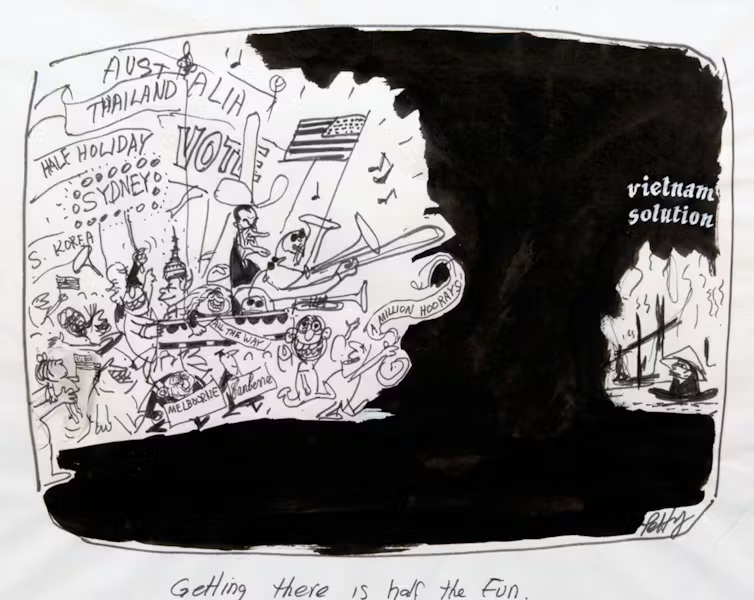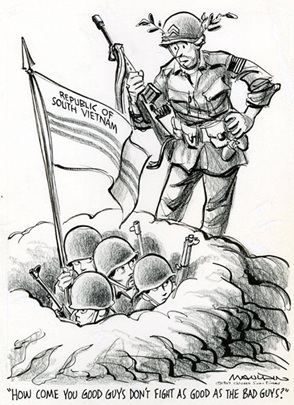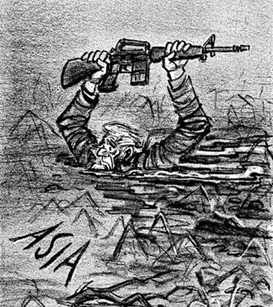|
    
Why the US lost / the NVA-VC won
|
NOTE:
amazingly, this topic is not mentioned on either the AQA or Pearson iGCSE
specification, but it is hard to believe that you will never get a question
which does not relate to it. It is a key topic on the Edexcel specification.
|
|

In 1966, President Johnson visited Australia to shore up support for the war. This cartoon by Bruce Petty
denotes the 'credibility gap' between the government hype, and the reality, of
Vietnam.
|
Going Deeper
The following links will help you widen your knowledge:
Basic account from
Clever Lili
An A-Level sample answer - studyclix (pdf)
Old texts:
from Mastering Modern World History - Norman Lowe (1988).
from Exam Essays in 20th Century World History
- Peter Catterall (1999)
YouTube
Why did the USA Fail in Vietnam? - Mr Cloke
|
|
These Sources show some of the things that have been said about why the US lost the Vietnam War:
Source A
It was naïve to claim that the United States could achieve victory with limited means in a civil war on the Asian mainland. It was equally naïve, I think, to assume that we could change or win the hearts and minds of people, democratize a country not remotely under our own control, and thus aim at nationhood through Saigon's government. American military forces and civilian bureaucracies are not finely tuned enough for such assignments.
An extract from American political scientist Richard Neustadt,
Vietnam Reappraised (1981).
Source B
We misjudged the intentions of our adversaries … and we
exaggerated the dangers to the United States of their actions.
We underestimated the power of nationalism to motivate a
people to fight and die for their beliefs and values.
We failed to recognise the limitations of modern,
high-technology military equipment.
We failed to adapt our military tactics to the task of
winning the hearts and minds of people from a totally different culture.
We failed to debate the pros and cons of a large-scale
military involvement … before we initiated the action.
After the action got underway we did not fully explain
what was happening, and why we were doing what we did.
We did not hold to the principle that US military
action … should be carried out only in conjunction with multinational forces
supported fully by the international community.
An extract from Robert McNamara, The Tragedy and Lessons of Vietnam (1995).
McNamara was US Defence Secretary during the War, 1961-69.
Source C
The problem with the American strategy was that, though the suffering of the enemy was great, it was not enough to make them concede. Throughout the war, the capacity of the north Vietnamese to absorb pain outstripped that of the Americans to inflict it. For the Americans the war was a ‘limited one’ far from home. For the north Vietnamese it was total: they were fighting to defend their homeland.
A modern historian’s view of why the Americans did not win the Vietnam War.
Source D
For the United States, the agreement signals the end of a nightmare. It promises the speedy and safe return of American troops and prisoners and then opportunity for fresh beginnings on neglected problems at home and abroad.
From the New York Times, 24 January 1973.
|
Source E

A cartoon by American cartoonist Bill Mauldin, whose son was
fightng in Vietnam (1967).
Source F

A cartoon by the American cartoonist Herblock, published in
January 1968, two days before the start of the Tet Offensive.
|
Consider:
- WHY THE USA LOST THE VIETNAM WAR [WANT OUT]
Look back through all the webpages in this unit
to make a list of all the different reasons you can see why the USA
failed in Vietnam.
When you have compiled your list, you may wish to compare
it to my suggestions by clicking on the orange arrow.
- 1.
Weaknesses of the US armed forces
Many US soldiers were young conscripts with poor training and morale – the US relied on inexperienced troops rotated in for a 1-year term of service. Drug use, racial tensions, fragging of officers and ‘working it out’ weakened discipline
- 2.
American tactics were inappropriate
US strategy relied on superior firepower – especially bombing and search and destroy missions – which caused civilian deaths but did not defeat the guerrilla enemy. Hearts and minds campaigns were too often undermined by the violence of other operations and included ‘pacification’ and surveillance.
US troops were unfamiliar with the jungles and rice paddies.
- 3.
No clear war aims or understanding of Vietnam
The US misjudged the nationalist motives of the Vietnamese (man in both South & North saw the US as another colonial occupier), treating the war purely as a fight against communism.
There was no clear military objective, and the US ground forces
were limited to South Vietnam.
- 4.
Tet Offensive shattered confidence
Though a military failure for the NVA-VC, the 1968 Tet Offensive shocked the American public and demoralised the soldiers.
It showed that the communists could strike anywhere and made a
mockery of official claims that victory was near.
- 5.
Opposition to the war in the USA
The anti-war movement (students, media, civil rights activists) turned public opinion. The My Lai massacre and the Tet Offensive exposed the credibility gap between government claims and reality.
Politicians faced growing pressure to withdraw, especially after
1968.
- 6.
Unpopular South Vietnamese regime
The US backed a series of unpopular governments in Saigon.
Leaders like Ngo Dinh Diem and his successors were corrupt,
repressive, and lacked legitimacy, which pushed more Vietnamese
to support the communists and weakened the moral right of the US
to be there.
- 7.
Threw in the Towel
By the early 1970s, both Democrats and Republicans wanted ‘peace with honour’. The cost of the war was damaging the US economy & the government’s domestic agenda.
Vietnamisation reduced US troop involvement and Congress cut
funding after 1973, and in 1975 no one was willing to restart
full-scale war after US withdrawal.
- WHY THE
NORTH VIETNAMESE WON THE VIETNAM WAR [CATCHUPS]
Now look back through all the webpages in this unit
to make a list of all the different reasons you can see why the North
Vietnamese won in Vietnam.
When you have compiled your list, you may wish to compare
it to my suggestions by clicking on the orange arrow.
- 1.
Chinese and Russian support
The USSR and China supplied weapons, equipment, training, and money throughout the war. Soviet-supplied MiG planes and surface-to-air missiles challenged US air superiority.
This support allowed the communists to keep fighting for years.
- 2.
Able and adaptive leadership
Ho Chi Minh, General Giáp, and other communist leaders combined nationalism with communist ideology, focussing on political as well as military victory.
They were flexible, learned from defeat and adapted to US
tactics over time.
- 3.
Tactics suited their war
The Vietcong used guerrilla warfare – booby traps, ambushes, sabotage, and hit-and-run attacks. They blended into the civilian population and used local knowledge to avoid defeat.
Their tactics made it hard for US forces to tell friend from
foe.
- 4.
Commitment and unity of purpose
North Vietnam saw the war as a fight for national liberation. Communist forces were prepared to accept massive losses.
Their long-term goal never changed, and they remained determined
even when facing defeat.
- 5.
Ho Chi Minh Trail
A vast
supply network through Laos and Cambodia, allowing the NVA-VC to
transport troops, weapons, and supplies into the South.
- 6.
US withdrawal gave final advantage
In 1975, the communists launched a conventional military offensive.
Without US air power and aid, North Vietnamese tanks entered
Saigon almost unopposed.
- 7.
Propaganda and psychological warfare
The communists used propaganda effectively to undermine morale among US troops and to gain peasant support.
They also portrayed the South Vietnamese govt as a puppet of US
imperialism.
- 8.
Support from many in the South
The Vietcong had genuine support in rural areas, especially where South Vietnamese governments were corrupt or repressive.
They built a shadow government in many villages and gained
loyalty through propaganda.
|
- AQA-style Questions
1. Source
E blames the ARVN for America's defeat. How do you know? Explain your answer using Source
E and your contextual knowledge..
2. How useful are Sources A and B to an historian studying the
reasons the US lost the War in Vietnam?
3. Write an account of how the unpopularity of the South
Vietnamese regime helped to defeat the Americans in Vietnam.
4. "The problem with the American strategy was that, though
the suffering of the enemy was great, it was not enough to make them
concede." How far do you agree with this statement?
Explain your answer.
-
iGCSE-style Questions
(a) Describe TWO features of EITHER US war aims OR North Vietnamese
propaganda.
(b) How far does Source
B support the evidence of Source F about the reasons the USA was
defeated in Vietnam. Explain your answer.
(c) Source
C suggests that the North Vietnamese triumphed because their
"capacity to absorb pain outstripped that of the Americans to inflict it", How far do you agree with this
interpretation?
-
Edexcel Questions
1. Give two things you can infer from Source D about why the US lost
the War in Vietnam.
2. Explain why Chinese and Russian support was important in
the North Vietnamese victory.
3a. How useful are Sources A and B for an enuiry into the
reasons why the USA was defeated in Vietnam.
3b. Sources E and F give different views about why the
Ameicans failed in Vietnam. What is the main difference between
these views?
|
|
|
Spotted an error on this page? Broken link?
Anything missing?
Let me know.
|
    
|


